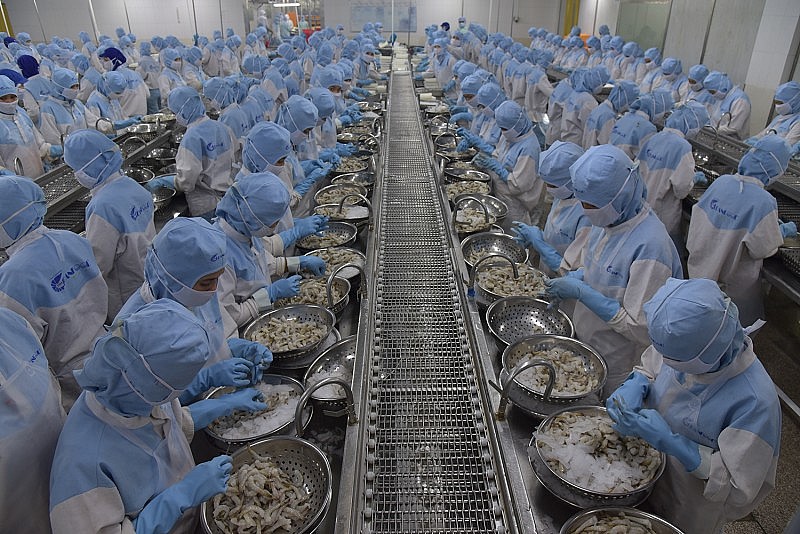 News
News
| Seafood exports to the US are expected to recover in the second half of 2023The reason shrimp exports in 2023 are forecast to reach only about 3 billion USD |
According to the Vietnam Association of Seafood Exporters and Producers (VASEP), Vietnam's shrimp exports to the United States in the first six months of this year reached $299 million, down 38 percent. In June 2023, shrimp exports to the US fell by 23%, the lowest decline since the beginning of the year. The value of Vietnamese shrimp exports to the US in June reached more than 71 million USD, the highest value since the beginning of this year.
 |
| Shrimp exports to the US market are expected to prosper soon in 2024 |
The reason why Vietnam's shrimp exports to the US market declined was due to inflation, tight spending, large inventories; reduce import incentives due to rising interest rates. On the other hand, the supply to the market increased from countries such as India, Ecuador, and Indonesia.
Notably, the cost of shrimp farming in Vietnam is high compared to competitors because of the operating and management costs for the small-scale production model, which does not maximize the efficiency of input materials.
"The expectation of low shrimp prices in the US has created a bottom and shrimp consumption for the end of the year has increased" , VASEP said.
Vietnam is currently ranked 4th in terms of shrimp imports to the US market due to Vietnam's diversification of products and supply chains in aquaculture and exporting countries (according to a report KIS Vietnam Securities Corp published in April 2023).
Although Vietnamese exporters have less competitive prices, the reputation of high-quality products has pushed Vietnam's shrimp exports to hold the Top 4 position with a compound growth rate of 18.9% over the past 5 years.
Commenting on the export market in the last 6 months of the year, Mr. Pham Quang Huy - Agricultural Counselor - Vietnam Trade Office in the US - assessed that interest rates have not increased, inflation is expected to be gradually controlled along with the recovery of purchasing power. The shrimp market in the US is expected to prosper in 2024.
According to Mr. Pham Quang Huy, market information and policies in the US are transparent and stable. Stable and committed US partners and customers. The prestige of Vietnamese export enterprises has also been confirmed. The increase in the price of essential foods and complementary foods helps to improve added value if the chain is well managed and operated. These are favorable factors for Vietnam's shrimp exports to the US market in the coming time.
In order to promote shrimp exports to the US market, Mr. Pham Quang Huy also recommended that domestic enterprises should strengthen links along the value chain from incubation, production, processing, distribution and consumption of products; develop shrimp farming models to help lower product costs, approach competitors' prices, etc.
Comply with regulations on production standards, food safety, labeling, registration of environmental, labor and origin standards. Keep full records of production and processing process to retrieve information and serve on-site verification by US authorities.
In addition, careful preparation is required, understanding consumer tastes, and understanding federal and state regulations, laws, and requirements. Always meet the requirements of food quality and hygiene; improve the processing content, diversify products (powdered shrimp, instant food, tempura...).
Actively promote, participate in trade promotion activities, actively approach official and specialized distribution channels including the system of Asian and Vietnamese supermarkets. Promote the use of e-commerce channels, especially in the context of the new normal. Develop models to link production, raw material suppliers.
4 Asian countries with highly similar shrimp products include: Vietnam, India, Thailand and China. In 2004, Vietnamese shrimp was investigated by the US Department of Commerce and concluded that anti-dumping duties were imposed from 4.30% to 25.76%. By July 2016, DOC unloaded 01 Vietnamese enterprise. After the administrative review POR 13, Vietnam has 2 mandatory defendants and 29 companies that enjoy separate tax rates of 0%.
On June 1, 2023, the US International Trade Commission (ITC) issued a notice unanimously upholding the anti-dumping duty order on shrimp imported from China, India, Thailand and Vietnam after the third final review after 5 years. The tariffs, which were continued during the 2017 sunset review, were 4.94-15.36% for India; 5.91-6.82% for Thailand; and 4.30-25.76% for Vietnam. Tariffs for China range from 0.07-112.81%.
US Customs and Border Protection said about $4.4 million in anti-dumping and countervailing duties collected would be available for distribution.
Shrimp accounted for only $3,270 in anti-dumping duties collected and available for distribution in fiscal year 2023, according to the Southern Shrimp Alliance (USA). These tariffs apply to goods imported from Brazil, Ecuador, India and Thailand into the United States before October 1, 2007.
Regarding trade remedies lawsuits against shrimp products in the US market, Mr. Pham Quang Huy recommended, when a lawsuit/dispute occurs, businesses need to actively cooperate with US authorities to provide documents to prove their activities.
Regularly communicate with Vietnamese authorities to capture necessary information and receive specific instructions.
Building traceability system, production line from raw shrimp to finished products. Document retention, transparent and convenient accounting system that can be provided in a short time, meeting the requirements of the US side.
Cooperate and provide information to the competent authorities of the two countries in checking data and verifying the origin of goods. Actively share information through industry associations and actively coordinate with state management agencies in solving arising problems related to trade and technical barriers.
| The United States is the world's largest shrimp consumer market, but shrimp production in the United States currently only meets 10% of domestic demand and must import up to 90%, of which 50 - 60% are farmed, warm/brackish water and frozen shrimp. The main shrimp suppliers to the US are Latin American countries such as Ecuador, Mexico, Argentina and Asian countries such as India, China, Thailand, Indonesia, and Vietnam. |